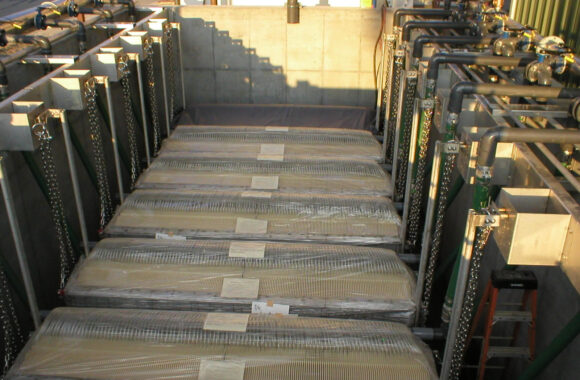Membrane Bioreactor (MBR)
Membrane Bioreactor (MBR)
The technologies most commonly used for performing secondary treatment of municipal wastewater rely on microorganisms suspended in the wastewater to treat it. Although these technologies work well in many situations, they have several drawbacks, including the difficulty of growing the right types of microorganisms and the physical requirement of a large site. The use of microfiltration membrane bioreactors (MBRs), a technology that has become increasingly used in the past 10 years, overcomes many of the limitations of conventional systems. These systems have the advantage of combining a suspended growth biological reactor with solids removal via filtration. The membranes can be designed for and operated in small spaces and with high removal efficiency of contaminants such as nitrogen, phosphorus, bacteria, biochemical oxygen demand, and total suspended solids. The membrane filtration system in effect can replace the secondary clarifier and sand filters in a typical activated sludge treatment system. Membrane filtration allows a higher biomass concentration to be maintained, thereby allowing smaller bioreactors to be used.
For new installations, the use of MBR systems allows for higher wastewater flow or improved treatment performance in a smaller space than a conventional design, i.e., a facility using secondary clarifiers and sand filters. Historically, membranes have been used for smaller-flow systems due to the high capital cost of the equipment and high operation and maintenance (O&M) costs. Today however, they are receiving increased use in larger systems. MBR systems are also well suited for some industrial and commercial applications. The high-quality effluent produced by MBRs makes them particularly applicable to reuse applications and for surface water discharge applications requiring extensive nutrient (nitrogen and phosphorus) removal.
The advantages of MBR systems over conventional biological systems include better effluent quality, smaller space requirements, and ease of automation. Specifically, MBRs operate at higher volumetric loading rates which result in lower hydraulic retention times. The low retention times mean that less space is required compared to a conventional system. MBRs have often been operated with longer solids residence times (SRTs), which results in lower sludge production; but this is not a requirement, and more conventional SRTs have been used. The effluent from MBRs contains low concentrations of bacteria, total suspended solids (TSS), biochemical oxygen demand (BOD), and phosphorus. This facilitates high-level disinfection. Effluents are readily discharged to surface streams or can be sold for reuse, such as irrigation.
Conventional Activated Sludge (CAS) mainly consist of two steps. The first one involves aeration tank, in which wastewater is treated with the aid of active microorganisms (i.e., activated sludge). The treated water and the activated sludge are separated in the sedimentation tank, or secondary clarifier. Activated sludge cannot be completely separated in the sedimentation tank and usually lighter fraction is carried out with the treated effluent. However, in the case of using MBR, because of the existence membrane with different pore size, most of the activated sludge can be separated.
:Advantages
- Allow uncoupling of the HRT and SRT
- Produce a high quality effluent
- Have a small footprint
.Provide better bio-treatment

